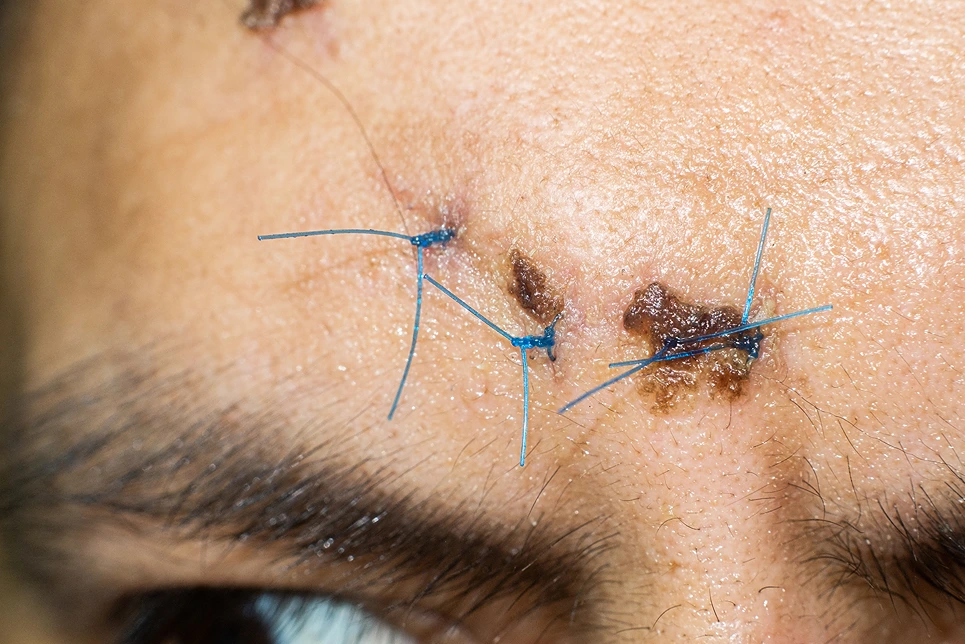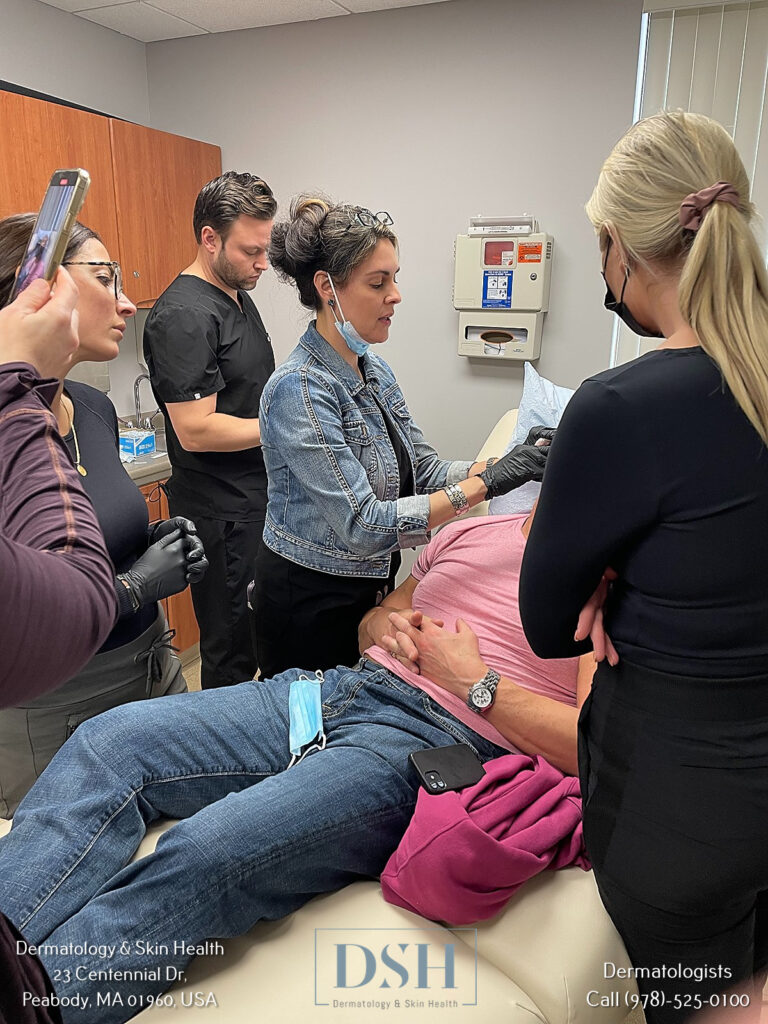

Skin cancer is frighteningly common, with over 5 million cases diagnosed in the United States each year.
While melanoma grabs headlines as the deadliest form, another type silently stalks sun-exposed areas like the forehead at an even higher rate. Basal cell carcinoma accounted for over 4 million cases last year alone, far outpacing any other skin malignancy. Fortunately, advanced techniques like Mohs surgery provide extremely high cure rates, even for complex basal cell carcinomas on delicate facial areas like the forehead.
Basal cell carcinoma arises from abnormal growth of basal cells, which reside in the outermost layer of the epidermis. Long term sun exposure can cause cumulative damage to these cells, leading to uncontrolled proliferation and tumor formation.
The face is a frequent site, especially areas that see the most sun like the forehead, temples, nose, lips and ears. In fact, over 90% of basal cell carcinomas occur on the head and neck.
In the initial stages, basal cell carcinoma may resemble a pearly bump or pinkish patch of skin. As it enlarges, the center often becomes ulcerated and crater-like. Dark blood vessels are sometimes visible under the surface. The borders tend to be waxy, elevated and translucent.
While the tumor rarely metastasizes, it can grow deeper and spread to surrounding tissue if not treated promptly.
On the forehead, basal cell carcinoma can be mistaken for a stubborn cyst, scar or pimple. Some warning signs specific to the forehead include:
Catching a developing basal cell carcinoma early on the forehead vastly simplifies treatment. Any suspicious sores or marks that linger longer than one month warrant evaluation by a dermatologist. A skin biopsy will confirm the diagnosis and appropriate therapy can begin before extensive growth or tissue damage occurs.
While basal cell carcinoma is typically slow growing, tumors on the sensitive facial skin require special consideration. Standard surgical excision provides effective treatment for cancers elsewhere on the body.
But the forehead's intricate network of sensory nerves and delicate tissue structures demand precise, tissue-sparing removal to avoid scarring and deformity.
That's where Mohs micrographic surgery delivers unmatched accuracy and cosmetic results. Developed in 1938 by Dr. Frederic Mohs, this technique offers the highest cure rate of any skin cancer treatment, up to 99% even for high-risk malignancies. It excels at eliminating basal cell carcinoma on aesthetically vital areas like the forehead while preserving healthy tissue.
The Mohs procedure, performed under local anesthesia in an outpatient setting, involves surgically removing the visible tumor and a thin layer of surrounding tissue. This removed tissue layer is meticulously mapped, color-coded, and examined under a microscope by the surgeon.
If any cancer cells remain at the edges, the surgeon precisely targets the involved areas to take an additional tissue layer. This process repeats until the microscope reveals a clear perimeter with no remaining cancer cells.
This method allows microscopic control and 100% margin visibility, ensuring no basal cell carcinoma remnants are left behind. Less tissue gets removed overall compared to other techniques because only cancerous zones undergo sequential excision. The unparalleled precision also leads to minimal scarring and optimal cosmetic results on delicate facial areas.
The prospect of facial surgery can provoke anxiety for any patient. Understanding exactly what the procedure entails helps ease the mind. The basic Mohs surgery process on the forehead involves:
Compared to standard excision, the surgery itself takes longer since tissue analysis occurs during the procedure. However, the total healing time is often faster with Mohs due to the tissue sparing nature.
Since Mohs preserves the maximum amount of healthy tissue, the recovery period is generally mild. Most patients experience:
To promote proper healing, patients should:
With Mohs surgery, most small to medium forehead defects heal without major cosmetic deformity. But larger defects may need additional procedures for the best aesthetic outcome on exposed forehead skin.

One advantage of the Mohs technique is precise mapping of the surgical defect. This allows the reconstructive or plastic surgeon to optimize repair options. The ultimate goal is restoring natural contour and appearance of the forehead.
For small defects, careful wound edge alignment and stitches often suffice. Linear closures can work for longer narrow defects. But wider gaps or deep crater-like cavities warrant more advanced options. The reconstructive techniques can be summarized as:
| Technique | Overview | Considerations |
| Primary Closure | Stitching wound edges together | For small defects only |
| Skin Grafts | Transplanting skin from another area | Risk of graft failure or mismatch |
| Local Flaps | Repositioning adjacent forehead skin | Limited tissue availability |
| Regional Flaps | Rotating nearby scalp skin | Requires some hair removal |
| Distant Flaps | Moving skin from neck, chest, etc | Staged procedures, more complex |
The forehead presents unique reconstructive challenges due to minimal tissue mobility across midline. But the rich vascular supply facilitates healing of flaps and grafts. The scalp also supplies abundant extra tissue along with hair follicles for ideal color and texture match.
Common repair techniques include:
Forehead reconstruction ranges from simple same-day procedures to multi-stage operations spanning weeks or months. Your Mohs surgeon will advise on repair options and optimal timing after considering defect size, location, depth and other factors.
Some patients may benefit from input of a specialized facial plastic surgeon. But with current techniques, even significant forehead and brow defects after Mohs surgery can be well concealed.

Basal cell carcinoma, the most prevalent skin cancer, can arise anywhere but favors the forehead and other sun-exposed facial areas. Standard treatments often prove inadequate on the delicate facial skin, leading to recurrence and tissue distortion over time. Mohs surgery offers an unrivaled cure rate by microscopically ensuring full tumor removal. The tissue-sparing precision optimizes cosmetic results on the aesthetically vital forehead.
By understanding the Mohs procedure, potential side effects, and recovery course, patients can prepare for the process both physically and emotionally. At Dermatology and Skin Health, our team of experts can provide the most advanced diagnostics and treatments to address any skin condition or cosmetic concern. Your dermatologic team will select the best closure method to minimize scarring.
Our patient-centered approach focuses on your goals to deliver customized solutions for optimal skin health and appearance. Contact us now to start your journey towards the best skin of your life!
If your desired appointment type or preferred provider is unavailable online, kindly call (978) 525-0100 for Peabody, MA and (603) 742-5556 for all New Hampshire locations. Alternatively please feel free to send us your request via the patient portal, or via email at info@dermskinhealth.com
*For medical dermatology appointments in MA please dial (978) 525-0100 or fill out the appointment request form above.